In this article, we’re going to talk about how to overseed a lawn.
Overseeding is an essential part of a lawns’ annual maintenance regime. It helps to keep your lawn thick and healthy, yet many gardeners fail to recognise how important it is.
As a result, millions of lawns up and down the country become thin and sparse with little grass. The perfect environment for weeds and moss to take over.
What is Overseeding and Why is it Important?
Like I said, overseeding is an essential part of a lawn treatment regime. It’s the process of spreading and sowing grass seed on an existing lawn.
There are a number of reasons why you might want to overseed your lawn, these include;
To Creating a Dense, Lush Covering of Grass
No one likes thin, patchy lawns.
They look unhealthy and are the perfect spaces for weeds and moss to inhabit.
Overseeding helps to create a dense covering of grass. This not only creates a thick, green, healthy-looking lawn, it also makes it more resistant to disease. And it crowds out weeds and moss, making it harder for them to grow and establish.
Aid Recovery After Invasive Treatments
Every so often it’s recommended that you rake, scarify and aerate your lawn. These treatments are designed to remove excess moss, thatch, relieve soil compaction, and to improve drainage and airflow.
Lawnsmiths who are in the pursuit of perfection also top-dress their lawns. This added topsoil makes for the perfect bed in which to spread grass seed.
These treatments can be done as part of a lawns’ annual care regime or as part of a full lawn restoration project. However, scarifying and aerating are pretty invasive and are likely to leave your lawn looking a bit worse for wear afterwards.
Overseeding with new grass seed will help the lawn to recover from these treatments as quickly as possible.
Change a Lawns Appearance or Tolerance
Overseeding allows you to gradually change the appearance of your lawn or increase its tolerance in different ways.
For example, let’s say you have an ornamental lawn that doesn’t cope very well with the kids and pets running around on it. Overseeding with a mix of harder wearing grass types will create the best of both worlds – a good looking lawn that’ll cope with the stresses your family puts on it.
On the other hand, you might have shady areas on your lawn where the grass is patchy and sparse. Overseeding with a grass blend that grows well in shady areas will improve both the look and tolerance of your lawn in those areas.
When to Overseed a Lawn
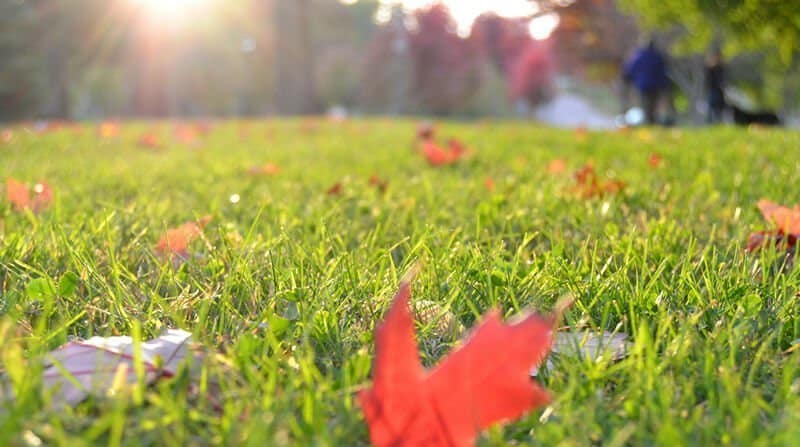
When learning how to overseed a lawn you must also pay close attention to when you do it. You want to make sure the new seed germinates and grows as quickly as possible.
Overseeding a lawn should be done when growing conditions for grass are at their best. This means plenty of sun, warmth and rain.
There are two times of year that provide these conditions.
Autumn and Spring.
I prefer to do it in Autumn. The soil still holds the warmth of the summer, there’s plenty of daylight and the rains bring the moisture. Plus, there are much fewer weed seeds floating around later in the year, when compared to spring.
That said, if you’re removing moss in the spring that has grown over the winter, you should definitely overseed.
Avoid doing it in the heat of the summer as you’ll likely not be able to provide the soil with enough moisture.
Believe it or not, some people advocate overseeding in the winter.
How Long Does it Take Grass Seed to Germinate and Grow?
Grass seed can take from 5-30 days to germinate and this depends on several factors which include;
- The type of grass seed you choose
- How much moisture and warmth is in the soil
- The weather in general, and
- How fertile the ground is
That said, most people should see germination within a couple of weeks.
Choosing a Grass Seed To Re-Seed With
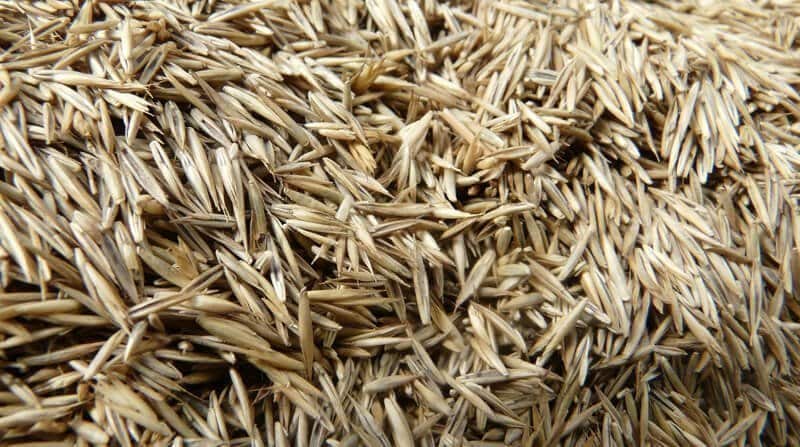
Many inexperienced gardeners get confused when choosing a grass seed to re-seed their lawn with. Others just buy the first bag or cheapest grass seed they see at the garden centre.
Don’t do this!
Instead, think about the following:
- How you use the lawn – is it simply a play area for the kids, a masterpiece or something in between? If it’s purely a play area, you’ll want a seed mix full of hard-wearing grasses. If your lawn is a work of art you’ll need a seed mix that’s purely made up of fine fescues. And if you want something in between, you’ll want a blend that contains both hard-wearing and fine grasses.
- How much sun or shade covers the lawn – some grasses grow better in shade than others and some need lots of light in order to thrive. Take a look at your lawn and see how much sun or shade your lawn gets throughout the day.
So Which Grass Seed Should You Choose?
Grass seed generally comes in four categories;
- Hard-wearing grasses
- General-purpose grasses
- Ornamental grasses
- Shady grasses
I recently wrote a whole grass seed buyers guide. It takes the guesswork out of which grass seed to buy because I tell you which is the best for each circumstance.
It tells you, if your lawn sits under a lot of shade, choose this grass seed. If you want a good looking lawn that’ll cope with the kids playing on it, choose this one.
You can read it here: Best Grass Seed UK: Reviews of Popular Products & Buyers Guide
What to Do Before Re-seeding Your Lawn
Overseeding isn’t just a case of chucking grass seed around.
It’s most often done to help the lawn recover after invasive treatments like scarifying which create an environment that encourages germination.
So before you do anything, inspect your lawn and look for the following;
Excessive Covering of Moss
Lots moss is a sign of other problems including excessive lawn thatch and soil compaction. This will prevent new grass seed from contacting the soil and as a result, it won’t germinate.
So if you have lots of moss covering your lawn, you’ll want to get rid of that first and then make other corrections (which we’ll get to in a minute).
The best way to do it is by raking out as much as possible first. Then, apply a good quality moss killer to kill the remaining moss before raking again.
This will get rid of 90% – 95% of the moss.
If it was really thick, you might find your lawn is quite bare after removing it.
If you want to learn more about killing and removing moss, read my Ultimate Guide to Removing Lawn Moss.
Excess Lawn Thatch
Lawn thatch is the build-up of dead organic material amongst the roots of the grass. It’s made up dead grass roots, old grass clippings and other organic matter.
Some thatch is a good thing, it protects the crown of the grass plant from damage and disease. However, too much can stop air, water, and nutrients from penetrating the soil which stunts grass growth.
If you spread grass seed onto a lawn that is thick with thatch, you’ll have wasted time and money. The thatch will prevent contact between the new grass seed and soil, therefore it won’t germinate.
In this case, you’ll need to scarify your lawn.
Soil Compaction
This occurs when the lawn is used heavily.
Soil particles get squeezed together which pushes out air, water, and nutrients and makes it very difficult for them to penetrate the soil.
It also makes it difficult for new grass seeds to germinate because they’re unable to grow roots in such hard soil.
Hollow-tine aeration is the process of removing cores of turf from the lawn. This creates space for the soil particles to relax and become ‘unstuck’ from each other. This encourages air, water, and nutrients to penetrate the soil and makes it easier for grass roots to grow and establish.
If you want to know if your lawn needs aerating and how to do it, read my Ultimate Guide to Lawn Aeration.
Soil Condition
Grass is a hardy plant and can grow even in very poor soils.
That said, if you have really heavy clay soil, the addition of sandy loam topsoil would improve things.
Similarly, if the soil is very sandy, the addition of a good quality loam topsoil will help.
To learn more about adding topsoil to your lawn, read my Guide to Top Dressing a Lawn.
At the very least you should make sure the soil has all the nutrients it needs. In which case, you should apply a fertiliser. Read my Guide to Lawn Fertiliser.
The Tools You’ll Need For Overseeding a Lawn
Here’s a list of everything you’ll need for overseeding;
Lawnmower
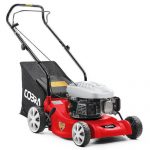 Before you spread new grass seed, you’ll want to cut the grass quite short. This will prevent new seed from getting stuck in the grass and make it easier to reach the soil.
Before you spread new grass seed, you’ll want to cut the grass quite short. This will prevent new seed from getting stuck in the grass and make it easier to reach the soil.
If you’re overseeding after scarification or as part of a lawn renovation, you should have already cut the grass pretty close.
 Grass Seed
Grass Seed
You can’t overseed a lawn without grass seed!
Like I said earlier, there are a few different types of grass seed available so consider which type will suit your needs and your lawn the best.
Read: Which is the Best Type of Grass Seed For Me and My Lawn?
 Pre-Seeding Fertiliser
Pre-Seeding Fertiliser
In order to give the new grass seed the best chance of germination and growing quickly, you should apply a slow-release, pre-seeding fertiliser.
This will add important nutrients to the soil that aid germination and strong root development.
Read: What’s the Best Lawn Feed? My Top Picks
 Lawn Roller
Lawn Roller
A lawn roller will help push the grass seed into the soil to create a good contact.
If you don’t have a roller, you can use a lawnmower with a roller on the back (turned off!) or you just tread the area using very small steps.
Seed and Fertiliser Spreader
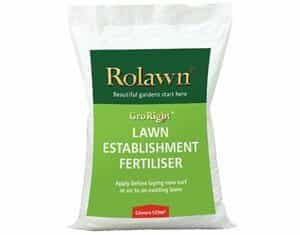 Spreading grass seed and fertiliser is pretty easy to do by hand if you only have a small lawn.
Spreading grass seed and fertiliser is pretty easy to do by hand if you only have a small lawn.
That said, it’s much more accurate with a spreader and if you have a big lawn, it’s really the only way to do it.
You can buy small, handheld spreaders for small areas or wheeled, broadcast spreaders for larger lawns.
 Hose and Sprinkler
Hose and Sprinkler
If the weather is on your side you might not need to water as the rain will take care of all that for you. That said, the weather very rarely does what we want it to.
In which case, you’ll need a hose and sprinkler.
When dealing with grass seed you’ll want to be careful that you don’t wash it away or drown it in water, so use a sprinkler with a fine spray setting.
Read: 6 of the Best Garden Hoses Tested and Reviewed
How to Overseed a Lawn, Step-by-Step
Re-seeding a lawn is a very simple process, that said, it is a process and it needs to be done right.
This video from Lawnsmith explains how to do it perfectly.
Step 1: Cut the Grass
When the grass is dry you’ll need to cut the grass quite low, maybe an inch or so.
If you’ve scarified, aerated, or if you’re renovating your lawn, you should have already cut the grass.
Cutting in quite short will help the new grass seed reach the soil instead of getting trapped in amongst the leaves.
Step 2: Spread the New Grass Seed
Now it’s time to spread the seed.
Spread it at the specified rate which, for overseeding, is typically 25g per square meter (but check!). So if your lawn is 100 square meters, you’ll need 2.5kg of seed.
If You’re Doing it By Hand
Split the grass seed into two equal lots and work in different directions for each lot.
For example, the first lot you might seed from north to south or from left to right, depending on how you look at your garden.
Then spread the second lot in the opposite direction. So from south to north or from right to left.
This will ensure a more even distribution.
If You’re Using a Spreader
Try using a smaller than recommended setting on your spreader. So 1/2 to 1/3 open instead of all the way.
This will probably mean more trips up and down the lawn but it will prevent you from running out of grass seed before you’ve finished.
Step 3: Knock the Seed Off the Existing Grass
Even though you cut the grass quite short, the chances are that grass seed will still get stuck to the existing grass.
And it can’t germinate there!
If you have a hosepipe or a landscaping rake, drag it across the lawn to knock the seed off the grass and into the soil.
Step 4: Roll the Lawn to Ensure Good Contact Between the Seed and Soil
Next, roll the lawn.
This will push the grass seed into the soil ensuring good contact.
If you don’t have a roller, use your lawnmower (if it has a roller on the back) or, simply tread your lawn using small steps.
Step 5: Apply a Pre-Seeding Fertiliser
With the grass seed down, you’ll want to give it the best chance of germinating.
This means adding nutrients to the soil with a fertiliser. So apply it at the specified rate.
If you’re doing it by hand or using a spreader, follow the same method we used for spreading the seed.
Step 6: Water the Lawn
If there’s no rain forecast, give the lawn a light watering for 30 minutes or so every day for a couple of weeks.
Use a fine spray and water enough to keep the soil moist but not so much that is washes the seed away or drowns it.
In Summary
Overseeding is a simple job but it’s an important one.
Now that you know how to overseed a lawn, you can keep yours thick, lush and healthy.
Oh, and a quick word on cutting the grass after re-seeding…
Mow your lawn as normal.
To reduce stress on the new seedlings, stick to once a week and keep the mowing height to at least 1.5 inches.
Now it’s Your Turn
I hope you enjoyed this article but more than that, I hope you’ve learned how to overseed a lawn and have the confidence to go and do it.
If you have any questions or if you’d like to share your experiences, leave a comment below.
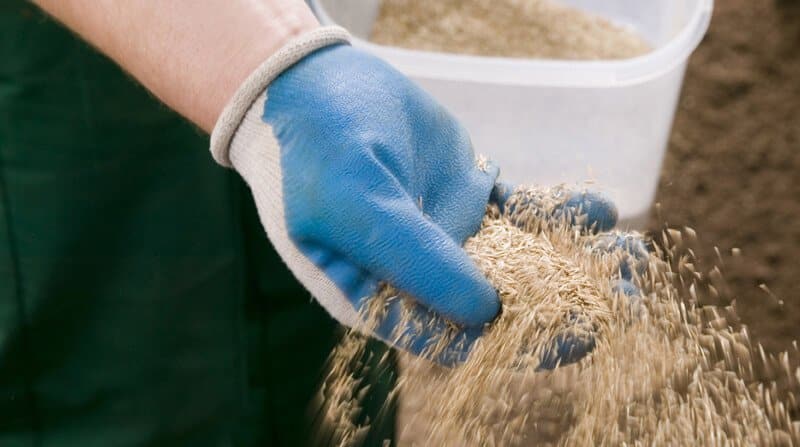
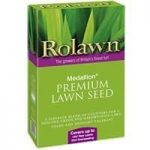 Grass Seed
Grass Seed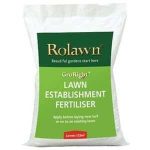 Pre-Seeding Fertiliser
Pre-Seeding Fertiliser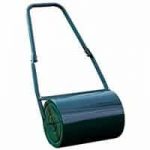 Lawn Roller
Lawn Roller Hose and Sprinkler
Hose and Sprinkler